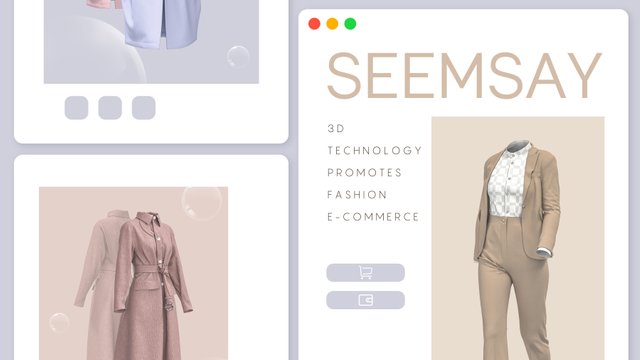How 3D Technology Promotes Fashion E-Commerce

Since the internet technology boom in 1990s, the retail industry has slowly crept into consumer’s daily lives, offering the public a more convenient purchasing option, without having to leave their homes. Along the advancement of the technology, the e-commerce industry, especially the fashion e-commerce, further evolves. 3D, as one of the most popular and practical technologies in many sectors, is a new solution for fashion companies to promote their e-commerce business.
· Enhance Customer Experience
In the fierce competitions between online fashion shops and brick-and-mortar stores, digital retails are weaker in providing interactive customer experience. Thanks to 3D clothing imaging, e-commerce can have a interactive display of apparels. 3D fashion design software like Browzwear and digital clothing platforms like Seemsay can generate 3D garment models, which allow customers thoroughly examine the clothes like they do in real life and have a better understanding of the properties of the garment. 3D clothing modeling can not only render a photo-realistic image of the product, but also enables customers to interact with the digital products - rotate the garment, check the garment from different angles or in different lights or zoom in to check the details of any parts of the clothes. Different from the traditional photo of products, 3D graphic representation let customers have a interactive browsing experience, which increases the time customers spend on page, and further increase the conversion rate.
· Reduce Cost and Save Time
Compared with manufacturing physical garment samples, the process of creating 3D clothing models can be carried out online, through which fashion brands are able to maintain their regular business during the COVID-19 pandemic. For fashion companies with 3D fashion design staff, 3D materials and garment models can be created with the use of 3D fashion design software. While other brands may choose to cooperate with 3D clothing solution vendors. Owing to the rapid development of 3D clothing platforms in the post-pandemic era, digital garment models can be easily created in three steps: upload the picture of the physical garment or the 2D drawings of designers to Seemsay 3D clothing service platform; review the 3D models created by the platform and give comments; and confirm the revised models.
Furthermore, 3D imaging has the power to reduce product return rate of e-commerce shops. According to the statistics of Global Webindex in 2019, clothing and shoes are the most frequently returned online products. Among the reasons that customers choose to return a piece of online clothes, sizing/fitting is the most common issue. Through implementing 3D visualization, e-commerce stores are gifted with a new function: virtual fitting room, where customers can try the clothes on 3D body models virtually and check the size and silhouette.
· Improve Marketing Strategy
The contents created by 3D clothing technology are marvelous resources for marketing activities. 3D images are more compelling to customers than traditional 2D photos. The strong marketing strategy with attractive pictures will make the products more saleable.
· Keep up with Industry Trend
3D clothing and modeling technology is the trend of apparel and clothing industry. As early as 2017, Amazon has acquired a 3D body modeling startup company to create 3D human body to develop garment virtual try-on function. As 3D clothing technology improves, there will be more and more fashion companies starting to adopt 3D garment visualization to create digital fashion experience for their customers. Lagging behind peers is more than losing competitive edge and opportunities. Stubbornly clinging to outdated ways may make fashion brands exposed to the risk of being eliminated by the market.
It’s not surprising that digital retail giants like Amazon have take actions to promote the development of fashion e-commerce, aiming to provide consumers more interactive shopping experience and advance the transition from traditional fashion to digital fashion. In additional to its tremendous values in 3D fashion design, 3D clothing technology has great potential in marketing and retailing. By applying 3D imaging to e-commerce, fashion brands are making a change. With 3D fashion design and clothing technology providers like Clo3D and Seemsay, mass consumers can easily get access to digital assets, which make e-commerce business totally different from before. We believe that 3D technology will drive e-commerce ahead.